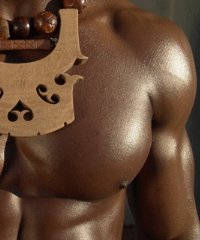
If you needed to buy groceries, would you walk into the store look around, buy nothing, go home and then pat yourself on the back for showing up? Probably not. If you are going shopping you have a specific purpose for being in the supermarket, it isn’t enough just to show up.
Likewise, if you are going to the gym or to exercise, you have a specific purpose. Showing up and flipping through the magazines isn’t enough. Browsing by in the grocery store won’t put food on the table and wasting your time at the gym isn’t going to give you the health, fitness and body you want.
Improvement Pattern – Habits, then Results
In my own experience I’ve noticed that most major improvements go through two phases. In the first phase, you focus on behavior and habits. Changing behavior is hard enough, so you make it your primary focus. This could mean saving a certain percentage of your income for investment to increase your financial health, working a certain amount of hours for your business and, yes, exercising regularly.
But after you establish behavior, you’re only halfway there. Next you need to focus on the results you want. Saving a tenth of your income is a pretty pointless exercise if you aren’t actually increasing your wealth. Going to the gym every day is a waste of time if you aren’t improving your health.
When you first form habits they aren’t usually optimized towards your goals. Going to the gym every day is better than nothing, but unless you are actually exercising hard at the gym then your habit is just getting you inside the building every day. Focusing yourself on specific results takes a pretty general habit, like going to the gym, and forces you to become more efficient in getting what you want out of it, like fitness and health.
Test Your Fitness Regularly
If you are at the point where you are exercising fairly regularly, the next step is to focus on your results. I test my fitness in several key areas every few months. I don’t necessarily do all the tests at once, but I keep track of my results so that I can have a better picture of where my health is.
Here are several of the items you can test to gauge your fitness:
- Weight – Your weight isn’t a great indicator of fitness, but it is easily measurable and works well as a test if you are particularly overweight.
- Endurance – I measure this by the maximum distance I can run at one time. On a good day I can do about 20 km so I might switch this to the time it takes me to run 10-15km. You could also measure endurance with biking, swimming, climbing or any extended physical activity.
- Speed – I usually measure how far I can run in 30 seconds or how long it takes me to run 250 meters or a kilometer.
- Number of Push-Ups/Chin-Ups – A good way of testing your strength is to count the number of complete push ups or chin ups you can do consecutively. This is a better measurement of your strength than the weight you can lift because push ups and chin ups move your entire body and require more stabilizer muscles then the benchpress or a machine.
- Number of Sit-Ups/Crunches – Along with push ups and chin ups I test my abdominal strength with the number of sit-ups or crunches I can do consecutively.
- Flexibility – Although your flexibility is harder to test with numbers, you know how far you can stretch your body. If you sit down with your knees locked can you touch your ankles? Toes? Grab your feet?
Ignore Results When You’re Starting
If you aren’t currently all that active, you should focus on your habits and less on results. Once you get most the behaviors put in place, you can optimize them to focus on the results you want.
If your gym going has been very irregular, I would start by creating a habit of exercising once a day. Once you have established a reliable schedule you can begin to focus more on the results you are getting. Setting a habit is a positive first step, but it isn’t the entire race. Get the improvement you want by testing your results.

 I'm a Wall Street Journal bestselling author, podcast host, computer programmer and an avid reader. Since 2006, I've published weekly essays on this website to help people like you learn and think better. My work has been featured in The New York Times, BBC, TEDx, Pocket, Business Insider and more. I don't promise I have all the answers, just a place to start.
I'm a Wall Street Journal bestselling author, podcast host, computer programmer and an avid reader. Since 2006, I've published weekly essays on this website to help people like you learn and think better. My work has been featured in The New York Times, BBC, TEDx, Pocket, Business Insider and more. I don't promise I have all the answers, just a place to start.